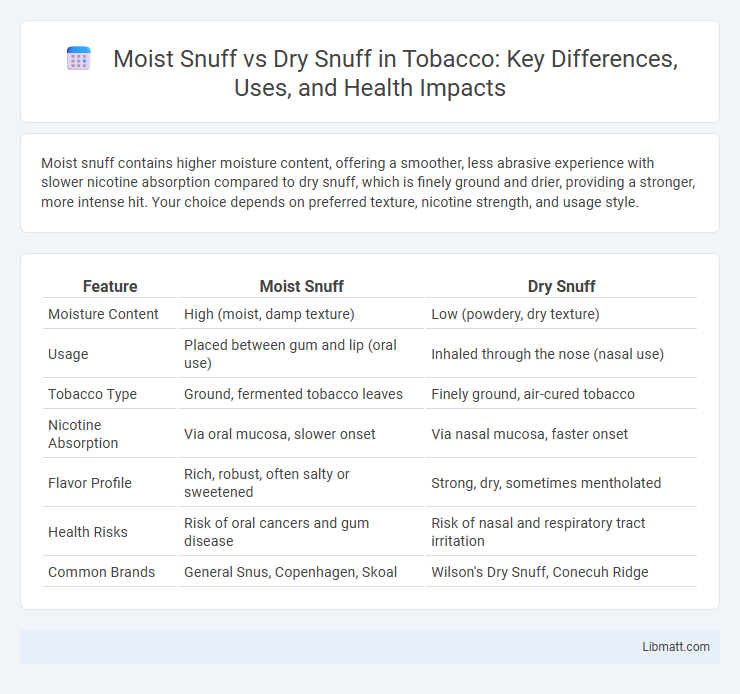Moist snuff contains higher moisture content, offering a smoother, less abrasive experience with slower nicotine absorption compared to dry snuff, which is finely ground and drier, providing a stronger, more intense hit. Your choice depends on preferred texture, nicotine strength, and usage style.
Table of Comparison
| Feature | Moist Snuff | Dry Snuff |
|---|---|---|
| Moisture Content | High (moist, damp texture) | Low (powdery, dry texture) |
| Usage | Placed between gum and lip (oral use) | Inhaled through the nose (nasal use) |
| Tobacco Type | Ground, fermented tobacco leaves | Finely ground, air-cured tobacco |
| Nicotine Absorption | Via oral mucosa, slower onset | Via nasal mucosa, faster onset |
| Flavor Profile | Rich, robust, often salty or sweetened | Strong, dry, sometimes mentholated |
| Health Risks | Risk of oral cancers and gum disease | Risk of nasal and respiratory tract irritation |
| Common Brands | General Snus, Copenhagen, Skoal | Wilson's Dry Snuff, Conecuh Ridge |
Introduction to Moist Snuff and Dry Snuff
Moist snuff dissolves slowly in the mouth, providing a steady release of nicotine and flavor, whereas dry snuff is finely ground and designed to be sniffed into the nasal cavity. Moist snuff typically contains higher moisture content, enhancing its smoothness and user experience, while dry snuff offers a quicker absorption through the nasal membranes. Understanding these differences helps you choose the product that best suits your preferences for nicotine delivery and usage style.
What is Moist Snuff?
Moist snuff is a finely ground, smokeless tobacco product typically placed between the gum and lip, delivering nicotine through oral mucosa absorption. It contains higher moisture content than dry snuff, enhancing flavor release and nicotine delivery while producing less nasal irritation. Popular brands like Copenhagen and Skoal cater to users preferring a moist texture and longer-lasting nicotine effects compared to dry snuff.
What is Dry Snuff?
Dry snuff is a finely ground, powdered tobacco that is typically inhaled through the nostrils, offering a rapid nicotine absorption without combustion smoke. It contains lower moisture content compared to moist snuff, resulting in a drier texture and a unique, intense flavor often preferred by traditional users. Your choice between moist and dry snuff depends on personal preference for usage method and flavor profile.
Key Differences Between Moist and Dry Snuff
Moist snuff contains higher moisture content, making it softer and easier to place between the gum and lip, while dry snuff is finely ground and usually sniffed through the nose. Moist snuff delivers nicotine more slowly through oral absorption, whereas dry snuff offers a quicker nicotine hit via nasal membranes. Your choice depends on preferred usage method and nicotine absorption speed.
Methods of Use: Moist vs Dry Snuff
Moist snuff is typically used by placing a pinch between the gum and lip, allowing the nicotine to absorb directly through the oral mucosa, which delivers a stronger and longer-lasting effect. Dry snuff, on the other hand, is usually inhaled through the nose, where the fine powder absorbs nicotine through the nasal membranes, providing a quicker but shorter sensation. Understanding these distinct methods of use can help you choose the product that best suits your preference and lifestyle.
Flavor Profiles and Varieties
Moist snuff offers a rich, robust flavor profile with a range of varieties including mint, wintergreen, and classic tobacco, delivering a smooth, long-lasting taste. Dry snuff typically exhibits a more intense, concentrated tobacco essence with earthy, smoky, or floral notes, favored by users seeking a traditional experience. Both types provide unique sensory experiences, with moist snuff focusing on moist, flavorful blends and dry snuff emphasizing bold, aromatic qualities.
Health Risks and Safety Considerations
Moist snuff contains higher moisture content, which increases nicotine absorption and poses greater risks of oral cancers, gum disease, and nicotine addiction compared to dry snuff, which with its low moisture can still cause respiratory irritation when inhaled. Both forms of snuff contain carcinogenic nitrosamines, but moist snuff's prolonged contact with oral mucosa elevates the risk of leukoplakia and periodontal damage. Safety considerations emphasize avoiding snuff use altogether to reduce exposure to harmful toxins and the risk of cardiovascular diseases and oral malignancies.
Popular Brands and Market Trends
Popular brands of moist snuff include Copenhagen, Skoal, and Grizzly, dominating the U.S. market with strong sales driven by flavored and nicotine-strength variations. Dry snuff brands like Wilsons of Shandwick and Carter Hall maintain niche popularity, particularly in traditional and European markets, with demand influenced by historical usage and artisanal production. Current market trends show a growth in moist snuff consumption due to rising interest in tobacco alternatives, while dry snuff experiences steady but limited market presence.
User Preferences and Cultural Significance
Moist snuff, favored in regions like the United States, is primarily chosen for its long-lasting flavor and higher nicotine content, appealing to users seeking extended satisfaction. Dry snuff holds cultural significance in parts of Europe and Asia, often used in traditional ceremonies and characterized by its fine powder form that is inhaled rather than placed in the mouth. User preferences are influenced by regional customs, sensory experience, and the desired method of consumption, with moist snuff dominating in contemporary markets and dry snuff maintaining historical importance.
Conclusion: Choosing Between Moist and Dry Snuff
Choosing between moist snuff and dry snuff depends on personal preferences related to texture, flavor intensity, and nicotine delivery. Moist snuff provides higher nicotine absorption and longer-lasting flavor due to its moisture content, while dry snuff offers a finer grind with a faster, more intense flavor burst but lower nicotine absorption. Understanding these differences helps users select the type that best suits their taste and consumption habits.
moist snuff vs dry snuff Infographic

 libmatt.com
libmatt.com